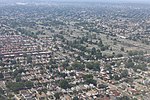Cambria Heights, Queens
Cambria Heights, QueensNeighborhoods in Queens, New York

Cambria Heights is a residential neighborhood in the southeastern portion of the New York City borough of Queens. It is bounded by Springfield Boulevard and Francis Lewis Boulevard to the west, the Elmont, Nassau County border on the east, Queens Village to the north, St. Albans to the west, and Montefiore Cemetery and Laurelton, Springfield Gardens and Rosedale to the south. As of 2010, Cambria Heights's population was 18,677. The neighborhood is part of Queens Community Board 13.
Excerpt from the Wikipedia article Cambria Heights, Queens (License: CC BY-SA 3.0, Authors, Images).Cambria Heights, Queens
225th Street, New York Queens
Geographical coordinates (GPS) Address Nearby Places Show on map
Geographical coordinates (GPS)
| Latitude | Longitude |
|---|---|
| N 40.695 ° | E -73.735 ° |
Address
225th Street 116-15
11411 New York, Queens
New York, United States
Open on Google Maps







